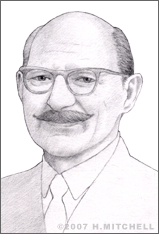Christopher Cockerell
In 1955, British inventor and engineer Christopher Sydney Cockerell invented a swift water-transport vehicle that was not quite a boat, not quite a plane, but a hybrid of sorts: the hovercraft.
Cockerell was born on June 4, 1910 in Cambridge, England. His father, Sir Sydney Carlyle Cockerell, was a distinguished devotee of the arts who served as director of the Fitzwilliam Museum and later as private secretary to Sir William Morris. He reportedly expressed reservations when his son made the decision to study engineering, but he supported him nonetheless and would later finance some of young Cockerell’s early patents.
Cockerell earned an engineering degree from Cambridge University’s Peterhouse College and worked for the Radio Research Company until 1935. That year, he joined the Marconi Wireless Telegraph Company. There, he was deeply involved in developing radar systems for use during World War II. He was named on 36 patents during his tenure with Marconi and was credited with inventions, such as an aerial direction finder used by airmen during the war, as well as equipment used to pinpoint the locations of German radar stations on the northern coast of Europe, which were then bombed in preparation for the Allies’ Normandy invasion in 1944.
In 1950, Cockerell left Marconi to manage a marina that he and his wife had purchased in Norfolk, England. While living in Norfolk, he began thinking about the concept of a heavy craft that could be supported on an air cushion and skim along the surface of a body of water without the drag produced by friction. He began experimenting with vacuum cleaner tubes and empty aluminum cans and found that when placing a small can inside a larger one and blowing air through the smaller can, it hovered above the bottom surface of the larger object. By 1955, he had a working prototype and pursued a patent for his creation, which he dubbed a “hovercraft.” He obtained a patent in 1956.
That year, he demonstrated his prototype craft, which used air blown out of the bottom of the craft under pressure, to British authorities and showed that it was possible to enable such a vehicle to glide easily over water and land, even mud and marshes. Meanwhile, American Charles J. Fletcher had invented a similar device called the “Glidemobile” during WWII. His design was classified by the U.S. Department of War, which denied Fletcher the right to patent the invention. Cockerell, however, having come up with his concept all on his own and having been the first to patent, is known as the father of the hovercraft that would come to be known and used around the world.
In 1958, shortly after Cockerell unveiled his prototype in England, the country’s National Research and Development Agency paid for an experimental vehicle based on his design to be built by a boat-building company called Saunders-Roe. The SR-N1 was launched on June 11, 1959, and later that year crossed the English Channel from Dover, England to Calais, France.
The NRDA established Hovercraft Development, Ltd. to develop the craft for commercial use and signed five companies up to build them. Cockerell served as director and technical advisor until 1966. The first passenger-carrying hovercraft was introduced in 1962 and was called the Vickers VA-3. Cockerell earned more than 50 patents on the hovercraft, while working both independently and for Hovercraft Development. He was knighted for his services to the engineering field in 1969. From 1974 to 1982, he served as Chairman of Wavepower, Ltd., a UK effort devoted to research on converting the energy of seawaves into electricity. He died in 1999.
Popularity of the hovercraft, meanwhile, has continued to grow as manufacturers have improved on Cockerell’s original concept. Since its introduction, the hovercraft has been used for human transport, for oil crew boats, for travel over mud and ice in challenging climates, and by national coastguards, military personnel, and fishery patrols.
Air cushion technology based on the hovercraft concept has also been used in fixed track systems, such as the Aérotrain, an experimental high-speed hovertrain built and operated in France between 1965 and 1977, as well as the Dorfbahn Serfaus, an underground air cushion funicular rapid transit system which has been operating in Serfaus, Austria, since 1985.


